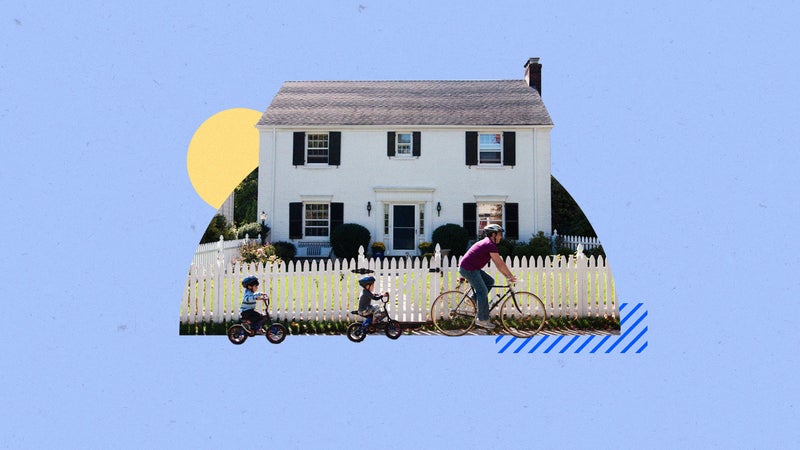Cash-out refinance: What it is and how it works

The Bankrate promise
At Bankrate we strive to help you make smarter financial decisions. While we adhere to strict , this post may contain references to products from our partners. Here's an explanation for .
Key takeaways
- A cash-out refinance replaces your current mortgage with a new, bigger loan. You receive the difference between the two in ready money.
- The process for a cash-out refinance is similar to a regular refinance but requires a larger loan: the balance of the old mortgage and cash borrowed against the home’s equity.
- The terms of your refinanced mortgage might significantly differ from your original loan, including a new rate or longer or shorter loan term.
- Although a cash-out refinance can be a convenient way to access large sums of money to pay debts or make renovations, it carries risks such as potentially higher interest rates and the danger of losing the home to foreclosure.
Paying down your mortgage helps build equity in your home, but you don’t have to wait until you completely repay your loan — or to sell the property outright — to access that equity. Instead, you can convert the equity you have into ready money, and continue paying off your mortgage, with a cash-out refinance.
Here how a cash-out refinance works.
What is a cash-out refinance?
A cash-out refinance turns your ownership stake into ready money by replacing your current mortgage with a new, larger loan. You receive the difference between the two in a lump-sum payment. You can use this money for any purpose, including home remodeling, debt consolidation, college tuition and other financial needs.
Cash-out refinancing is beneficial if you can reduce the interest rate on your primary mortgage and make good use of the funds you take out.— Greg McBride, Bankrate Chief Financial Analyst
How does a cash-out refinance work?
The process for a cash-out refinance is similar to that of a regular refinance (aka a rate-and-term refinance), in which you simply replace your existing loan with a new one, usually at a lower interest rate or for a shorter loan term, or both. The difference: You’ll get a new loan for a larger amount that includes the balance of the old loan and cash you withdraw from your home’s equity. The process involves:
- Figuring out how much cash you need: Because you need to repay the new mortgage with interest, it’s best to target how much you need to withdraw and for what purpose, rather than cashing out an amount you think you might use. Cash-out refinances are generally best for big-ticket costs: Think home renovations or consolidating higher-interest debt.
- Determining whether you qualify: Many cash-out refinance lenders require a credit score of at least 620 and at least 20 percent equity in your home.You might find lenders with looser requirements, but you could pay a higher rate as a result.
- Shopping around for the best cash-out refinance rates: Compare at least three different lenders to get a sense of what you qualify for and what rates look like today (refi rates are pretty comparable to regular mortgage rates). If you can’t get a lower rate than the one you have now, it might not make sense to do the refi at this time.
How much cash can you get with a cash-out refinance?
In the realm of conventional loans (those funded and backed by private lenders), mortgage lenders typically allow you to borrow up to 80 percent of the home’s value with a cash-out refi. However, this threshold varies depending on the property type. For a multifamily home, for example, you often can only borrow up to 75 percent.
The figures vary with government-backed loans. For an FHA loan cash-out refinance, you might be eligible to borrow up to 80 percent of the value of your home. But with a VA loan cash-out, you could qualify to tap all of your home’s equity.
Cash-out refinance requirements
Just as you did with your original mortgage, you’ll need to meet qualifying criteria to be eligible for a cash-out refinance. These requirements include:
- Credit score: You’ll generally need a credit score of at least 620 to qualify. Of course, a higher credit score gets you a more competitive interest rate.
- Debt-to-income (DTI) ratio: Your monthly debt payments divided by your gross monthly income, expressed as a percentage, equals your DTI. It should be 43 percent or lower.
- Equity: Lenders want you to have at least 20 percent in home equity — own at least one-fifth of your home outright, that is — although some will approve you if it’s a bit lower.
- Seasoning: Conventional cash-out refis come with a six-month seasoning requirement If you’re seeking a VA or FHA cash-out refinance, the seasoning period is 210 days and 24 days, respectively.
Pros and cons of cash-out refinancing
Pros of cash-out refinance
- You can lower your interest rate: This is the most common reason borrowers refinance. If you can get a lower rate than your current one and take out equity, it can be a win-win scenario.
- Your cost to borrow could be lower: Cash-out refinances often have lower rates than home equity loans, personal loans and credit cards.
- You can improve your credit: If you use your equity to consolidate debt, your credit utilization ratio (the amount of your outstanding balances compared to your overall credit limits) could drop. This can be a boon for your credit score.
- You can take advantage of tax deductions: If you use the funds for home improvements, you could deduct the interest on them on your federal tax return.
Cons of cash-out refinance
- Your interest rate might go up: You may qualify for the best rate around, but if interest rates have risen substantially since your original mortgage, odds are you’ll pay more on your new loan. And since the new mortgage is bigger, you’ll be charged more in interest too.
- You could be prolonging repayments: If you’re using a cash-out refi to consolidate debt, make sure you’re not prolonging over decades repayments you could have paid off much sooner and at a lower total cost otherwise. “Keep in mind that the repayment on whatever cash you take out is being spread over 30 years, so paying off higher-cost credit card debt with a cash-out refinance may not yield the savings you’re thinking,” says Greg McBride, chief financial analyst for Bankrate.“Using the cash out for home improvements is a more prudent use.”
- You have a greater risk of losing your home: A cash-out refinance increases your mortgage balance. Failing to repay the loan means you could wind up losing it to foreclosure. Don’t take out more cash than you need, and make sure you’re using it for a purpose that will improve your finances instead of worsening your situation.
Is a cash-out refinance right for you?
The collateral involved in a cash-out refinance — your home — means that lenders take on relatively little risk and can afford to keep refinance rates somewhat affordable. That means that cash-out refinancing is one of the cheapest ways to pay for large expenses. Many borrowers use the proceeds for the following reasons:
- Home improvement projects: You could use a cash-out refinance to renovate your home or add an addition, for example.
- Investments: You could purchase an investment property using a cash-out refinance.
- High-interest debt consolidation: Refinance rates tend to be lower compared to other forms of debt like credit cards. You can use a cash-out refinance to pay off these debts and pay the loan back with one, lower-cost monthly payment instead.
- College education: Tapping into home equity to pay for college can make sense if the refinance rate is lower than the rate for a student loan.
Alternatives to a cash-out refinance
If a cash-out refinance doesn’t work for you, here are some alternatives to consider. The first two also involve tapping your home equity.
- HELOC: A home equity line of credit, or HELOC, allows you to borrow money when you need to with a revolving line of credit, similar to a credit card. HELOC interest rates are variable, fluctuating with the prime rate.
- Home equity loan: A home equity loan gives you a lump-sum payment just after closing. Like a HELOC, it’s a second mortgage secured by your home.Unlike a HELOC, though, home equity loans have a fixed-rate and you start repaying them immediately.
- Personal loan: A personal loan is a shorter-term loan that provides funds for virtually any purpose. Personal loan interest rates vary widely and can depend on your credit, but the money borrowed is typically repaid with a monthly payment, like a mortgage.Unlike a refinance, they can require less paperwork and can be approved and funded the same day you apply.
- Reverse mortgage: A reverse mortgage allows homeowners aged 62 and up to withdraw cash from their homes. The balance doesn’t have to be repaid as long as the borrower lives in and maintains the home and pays their property taxes and homeowners insurance.
Cash-out refinance FAQ
-
The closing costs on a cash-out refinance (and any type of refinance) are almost always less than the closing costs on a home purchase. For a cash-out refinance, the lender charges an appraisal fee, and might charge an origination fee, often a percentage of the amount you’re borrowing. With a cash-out, you’re getting a larger loan, so the origination fee reflects that.
-
You can use money from a cash-out refinance however you want to. There are no limitations. However, common uses include:
- Doing home improvement and renovation projects
- Consolidating high-interest debt
- Paying for education
- Putting a down payment on an investment property
-
A rate-and-term refinance is a new mortgage that is the same size as the old one (the outstanding balance, that is). It only adjusts your interest rate and the loan’s term length. In contrast, a cash-out refinance is a new loan for a larger sum than the old. It also allows you to adjust your rate and term, though.
-
Both a cash-out refinance and a home equity loan allow borrowers to tap their ownership stake in their homes, and both use the home as collateral for the debt. But there are some major differences. Cash-out refinancing involves taking out a new loan for a higher amount, paying off the existing one and obtaining the difference in cash. A home equity loan, in contrast, is a separate, additional mortgage. It doesn’t replace your first mortgage. Home equity loans typically have a higher interest rate than cash-out refis.
-
Yes, in most cases. The mortgage lender needs to know what your home is worth to calculate how much equity you have, and from that, how much you can borrow.
-
Your payment could change depending on a couple of factors: the rate you’re refinancing to and how much equity you’re pulling out. If you’re refinancing to a much lower rate, you could end up with a similar payment, even with taking on a larger loan. Conversely, if the rate is similar or higher to your current one, your payment will go up because the loan amount has increased. It will also increase if you shorten the loan term – from 30 years to 15 years, for example.



